AWS Contact Center
Getting started with ML-powered Amazon Connect forecasting, capacity planning, and scheduling
Contact centers represent one of the most important touch points for businesses to resolve customer issues. When customers need assistance, it is critical for contact centers to have the right agents available to provide a positive customer experience. Ensuring the right agents are staffed at the right time requires contact center managers to consider an often overwhelming number of factors, like uneven contact volume patterns, agent attrition, regional labor laws, and more. To solve for this, some organizations use spreadsheets to manually forecast customer demand and schedule agents accordingly, which is labor intensive and inefficient. Others rely on expensive and difficult-to-integrate third-party solutions that still deliver a disjointed experience. We believe contact centers, irrespective of their size, need these native capabilities to efficiently staff and optimize agent schedules. This helps them improve both customer experience and agent experience while managing their operational costs, 75% of which are driven by staffing (per an FCBCO report).
We are excited to announce the general availability of Amazon Connect forecasting, capacity planning, and scheduling, a new set of ML-powered capabilities that make it easier for contact center managers to accurately predict customer service workloads, determine ideal staffing levels, and schedule agents accordingly, and ensure agents are performing their duties as scheduled. These new capabilities help companies easily optimize staffing across the whole contact center to deliver a positive experience for both customers and agents. Amazon Connect forecasting, capacity planning, and scheduling are available the US East (N. Virginia), US West (Oregon), Canada (Central), Europe West (London), and Asia Pacific Southeast (Sydney) AWS Regions.
Getting Started
You can enable Amazon Connect forecasting, capacity planning and scheduling for your Amazon Connect instance directly from the AWS Console with just one click!

Once complete, you will be able to access the below capabilities from within the Amazon Connect dashboard. Administrators can then provide access for forecasters, capacity planners, schedulers, agents, and their supervisors via Amazon Connect Security Profiles.
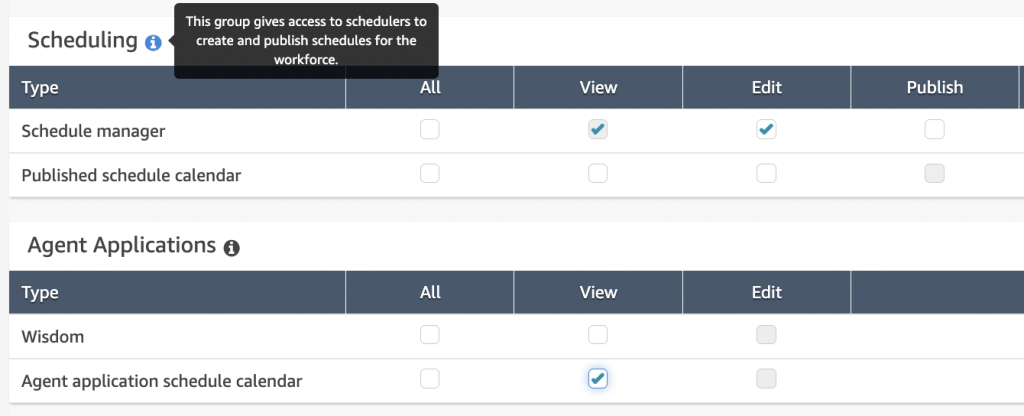
Based on your access permissions, you will be able to access three capabilities from within Amazon Connect:
Forecasting to predict demand
Amazon Connect forecasting helps you determine future contact volumes and average handle times. Once enabled, you can quickly drag and drop related queues that can be configured in Amazon Connect into Forecast Groups.

You can then use the Create Forecasts button on the Forecasts page to schedule forecasts for select Forecast Groups. Amazon Connect generates short-term and long-term forecasts for the Forecast Groups you specify. Long-term forecasts are generated for a 12 month horizon with daily granularity, and automatically refresh weekly. Short-term forecasts are generated for an 18 week horizon with 15 or 30 minutes granularity, and automatically refresh daily. If you’ve recently migrated to Amazon Connect, you can import supplemental historical contact volume & average handle time (AHT) data easily.
Once generated, the Forecasts page provides graphical and tabular views of your data, broken down by queue-channel (Voice and Chat are available in preview). You can export forecasts in CSV format to use with external applications or to make precision changes to specific forecasted values and import it back to override the generated forecast. This helps the forecaster support external planned events, like product launches, which can lead to atypical future contact activity. Once you are satisfied, you can publish the forecast to make it available for capacity planning and scheduling.
Capacity planning to help with your strategic hiring needs
Amazon Connect capacity planning will help simplify long-term resource planning. Strategic capacity planners can run “what-if” scenarios with varying attrition rates, per channel service levels, Average Speed of Answer targets, in-office or out-of-office shrinkages, maximum occupancy, overtime, and time off targets to determine the Full Time Equivalent (FTE) requirements for the next 12 months. This will help you build effective and efficient resource hiring, ramp up, deployment and budgeting strategies.
You can create scenarios by clicking the Create A Scenario button from within the Planning Scenarios tab.
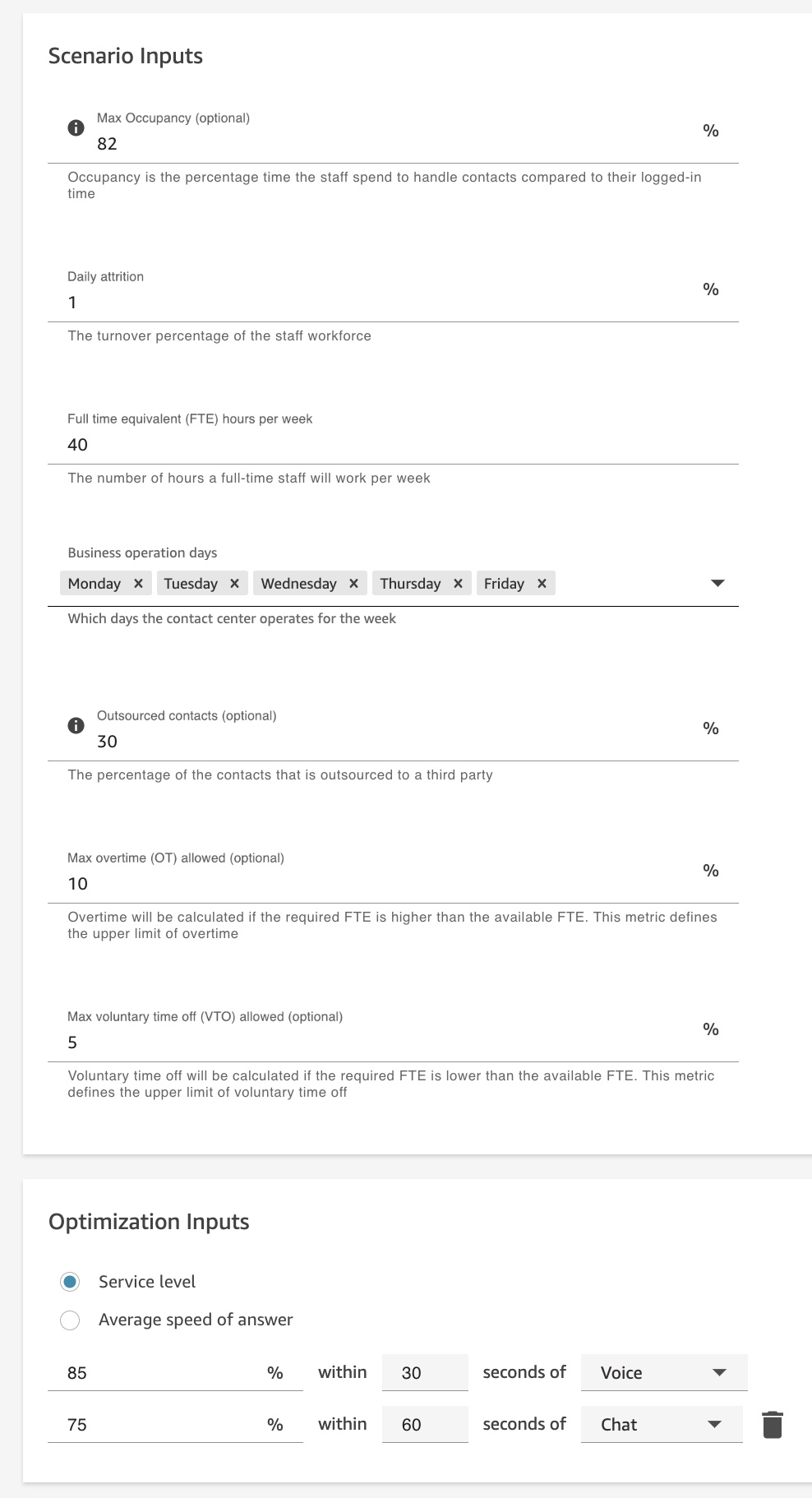
The output of the capacity plan shows a week-by-week or month-by-month calculation of the forecast contact activity, required and available FTE, and any overtime (OT) or voluntary time off (VTO) required to cover the gap between these two metrics. For example, if there is a supply deficit (required FTEs higher than available FTEs), required OT% indicates how much overtime would be needed to cover the deficit. If there is a supply surplus (required FTEs lower than available FTEs), required VTO% indicates how much voluntary time off could be used to lower the agent idle time and thus lower costs.

You can supplement future shrinkage and available Full Time Equivalents (FTE) data via a CSV file import workflow or override capacity plans post generation to make precision adjustments before publishing them to make it official. Capacity plans can also be exported.
Scheduling to ensure agents are available for your customers whenever needed
New ML-powered agent scheduling for Amazon Connect simplifies generation of highly accurate interval staffing and efficient schedules for your contact center agents, ensuring your business needs are met while complying to regional human resources and business rules.
To generate a schedule, first define activities that agents would do during the course of a shift such as meeting or break from within the Shift Activities tab.
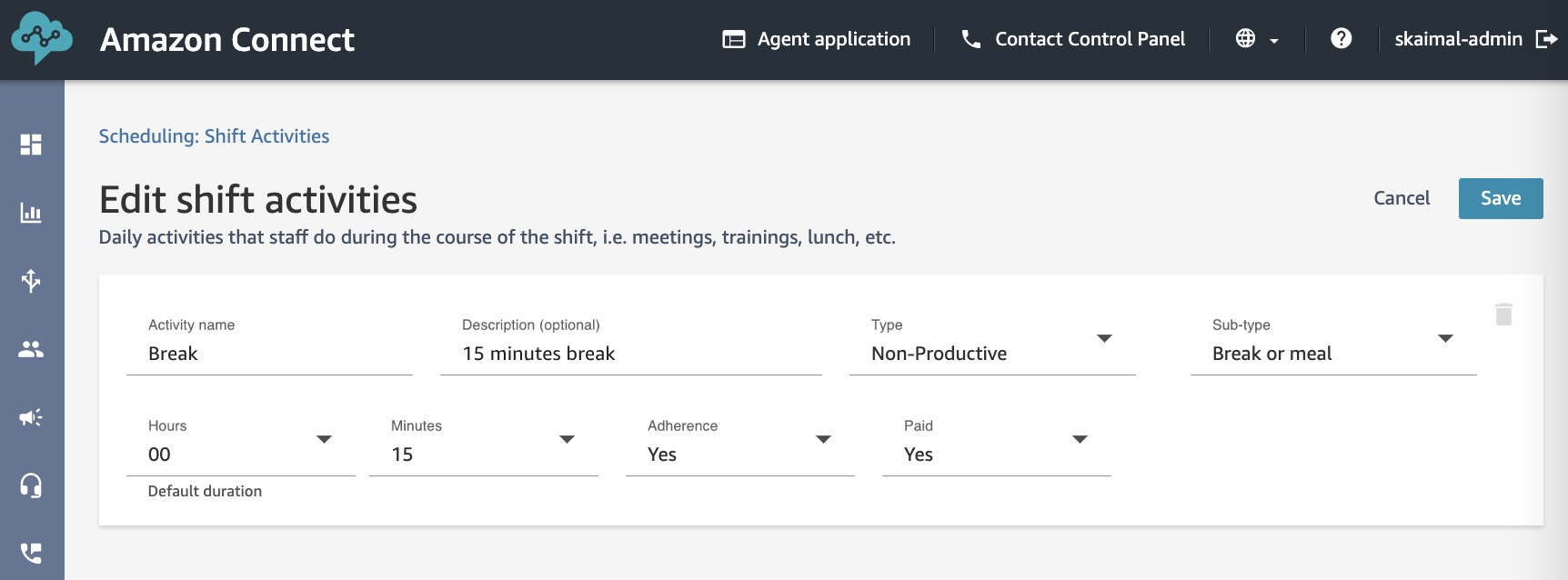
Then define a Shift Profile, which combines a schedule window (what days of the week and what times in a day agents would work) with the daily Shift Activities they would perform with their relative placements. Break placement rules can be optionally specified to ensure agents are not overworked when managers make manual schedule adjustments.

Agents who have similar skills or work similar shifts can be defined in a Staffing Group; multiple Staffing Groups can be associated to a Forecast Group. You can define one or more Staffing Groups, add agents and supervisors, and associate the right Shift Profile and Forecast Group to each Staffing Group.

HR/Legal/Business rules can be defined at the Staffing Group level or at the Staff (agent) level, and will be considered when scheduling agents. You can configure Staffing Group level rules to apply them to all agents in the group. You can also enable or disable time off request management and define the daily allowed time off hours per Staffing Group here.
The Staff Rules tab allows you to define rules at the agent level. Note that agent level rules override Staffing Group level rules. For example, if you have a mix of full-time and part-time agents in a Staffing Group, you can set maximum working hours to 40 hours per week for full-time agents and set it to 30 hours per week for part-time agents.

Now you are ready to generate schedules for any period covered by the short-term forecast, up to 12 weeks (in preview).
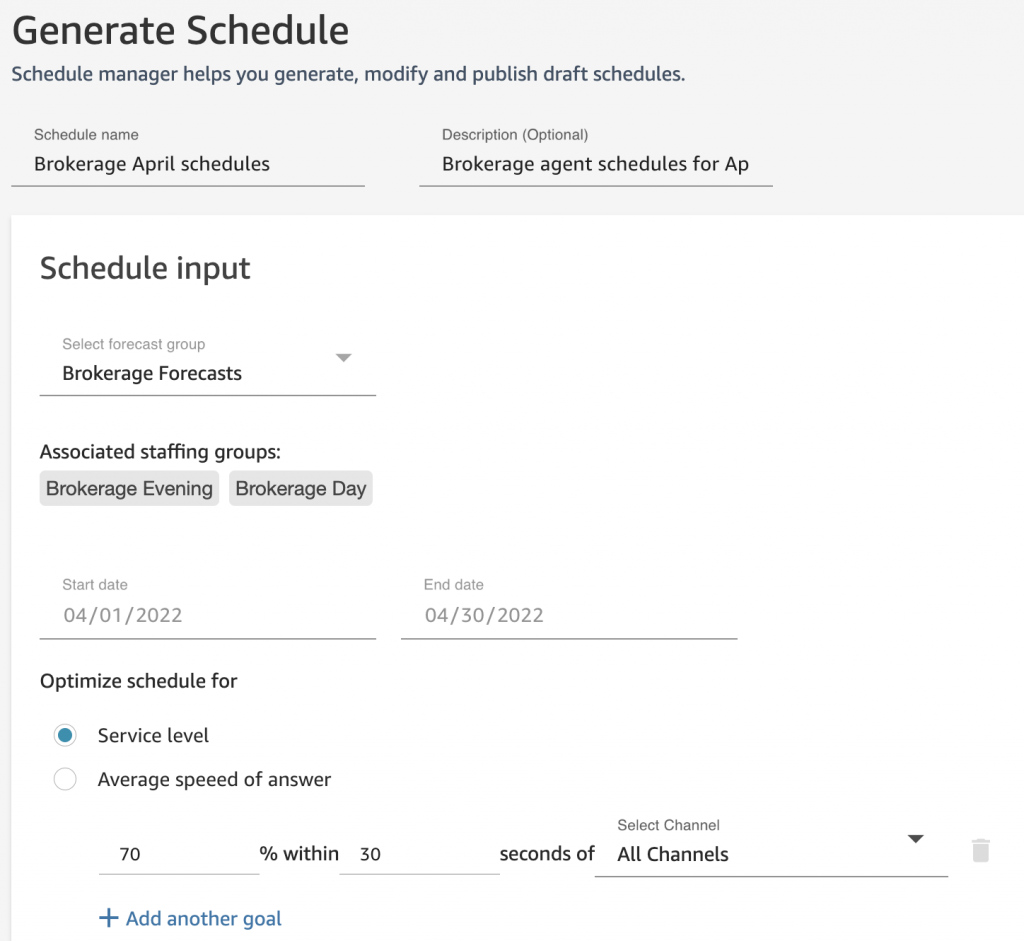
Once generated, you can view the generated schedules, failed constraints, interval level staffing metrics, and if needed, make precision adjustments to schedules.

Once all schedule adjustments are complete, the scheduler can publish the schedules using the Publish button, and supervisors can make changes to the published schedules.
Agents can access their individual schedules via Amazon Connect’s agent application, a single-pane-of-glass experience for agents to handle contacts and view contacting customer details and contact history. The agent application enables agents to deliver a personalized engagement and get real-time next best action recommendation that helps them serve their customers faster and more consistently.

Agents can click on the calendar icon to view their schedule.
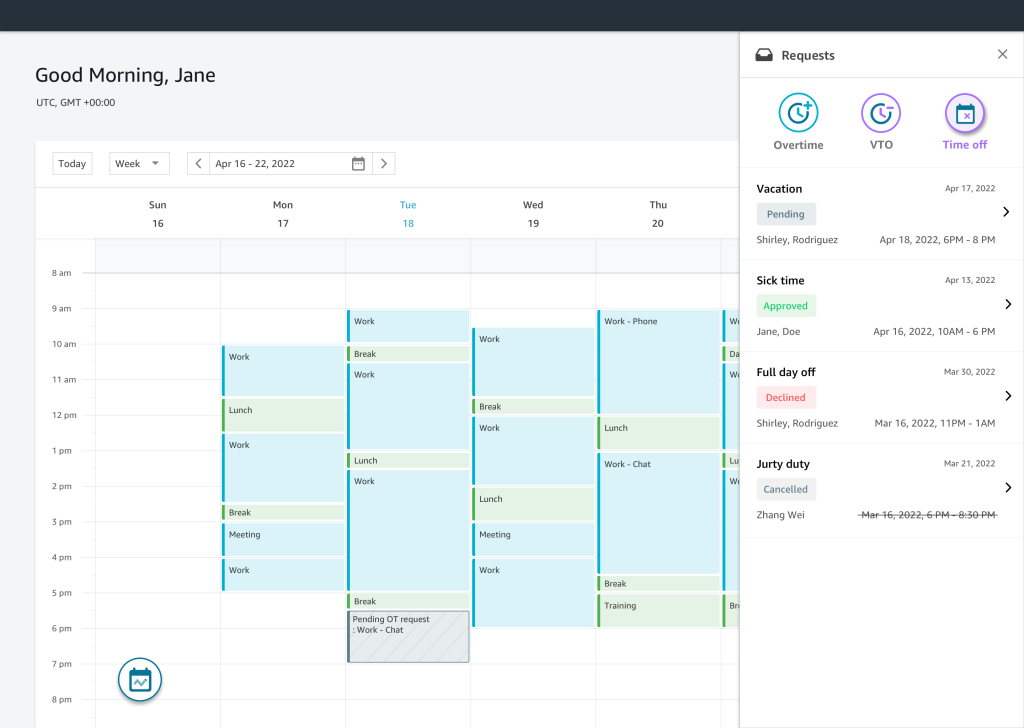
Agents have the flexibility to choose when they want to work overtime or take time off within predetermined limits set by their managers without the need for manual approvals. When agents accept overtime or time off slots, Amazon Connect uses machine-learning to make real-time schedule updates, such as moving or creating additional rest breaks, freeing managers to focus on reviewing performance metrics, and coaching agents.
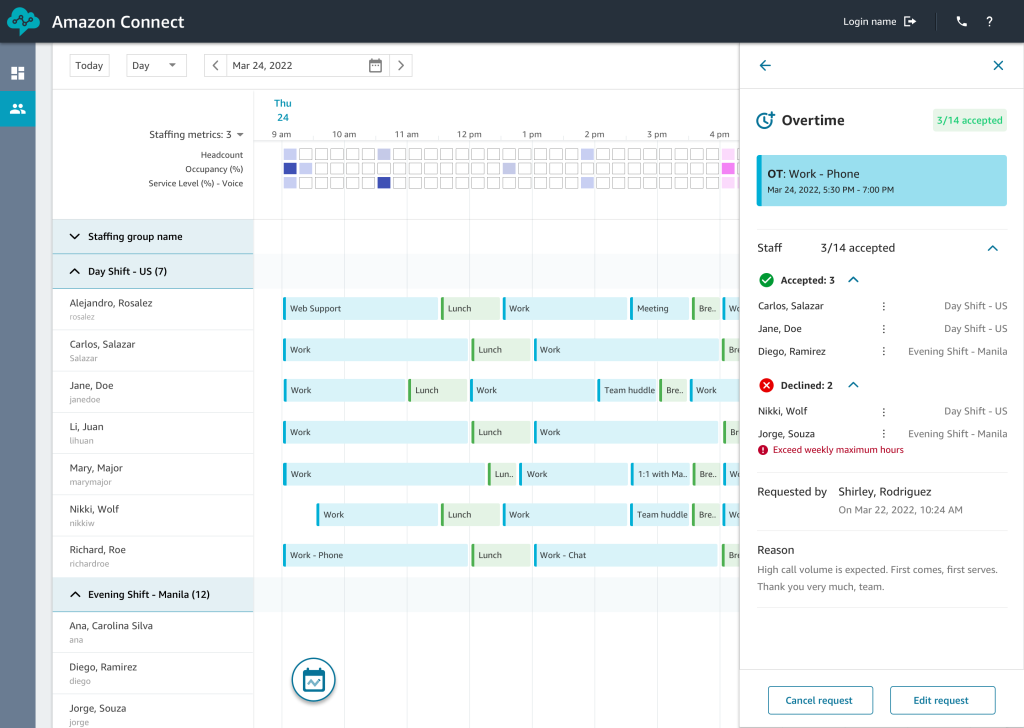
Managers with permissions however can override decision at will.
Hear from some early adopters
“One of our biggest challenges with our legacy contact center was forecasting customer demand based on historical data so we could predict surges,” said Alex Miles, Director of Business Intelligence at Litigation Practice Group. “When searching for a new provider, Amazon Connect stood out to us because of how easy it is to harness data and leverage machine-learning (ML) to deliver highly accurate (>95%) forecasts and optimized schedules. It is simple and flexible to set up, and allow us to create agent schedule with high efficiency, even when our agents have many unique schedule requirements. It ensures the right agent is available at the right time to take an end-customer’s call. With Amazon Connect forecasting, capacity planning, and scheduling capabilities, we are finally confident we can reliably hit our service-level targets and gracefully navigate fluctuations in customer demand.”
“As a business with seasonally driven volume, it is imperative that our contact center can scale up and down without being locked into expensive licenses. We needed a dynamic, easy to learn and administer telephony solution that is also cost effective, drives efficiency, and integrates seamlessly with our current and future technologies,” said Anjanette DeCoudreaux, Director of Participant Services, Ameriflex. “We’ve started using Amazon Connect forecasting, capacity planning, and scheduling to administer scheduling plans and coordinate real-time adjustments with multiple internal and external partners. Our business users without workforce management experience find the capabilities easy to use. AWS has been proactive in providing optimization recommendations and responsive to our development requests. Being able to work with AWS to test and build these forecasting, capacity planning, and scheduling capabilities that meet our business needs, rather than force fit a solution, has been an important part of our decision to move forward with additional AWS services.”.
AWS partners embrace new features for Amazon Connect forecasting, capacity planning, scheduling and adherence. Amazon Connect has over 80 system integrator (SI) partners globally who have passed Service Delivery Program (SDP) for Amazon Connect. The program is designed to validate AWS Partners that have deep technical knowledge, experience, and proven success in delivering specific Amazon Connect services to customers. Although Amazon Connect forecasting, capacity planning and scheduling is an integrated feature, customers who do not have workforce management expertise can choose to engage experienced with AWS partners to. This is to help them quantify the talent requirements to meet business objectives over the short and long term, use the data to improve business planning and financial forecasts, and establish metrics that help inform leadership about key workforce issues. The following four launch partners have helped their customers by deploying and configuring Amazon Connect forecasting, capacity planning scheduling and schedule adherence: HCLTech, Cognizant, Aspen, and Consilium.
Conclusion
Amazon Connect’s new ML-powered forecasting, capacity planning and scheduling capabilities ensure the right agents are available at the right time to help contact centers achieve their business and operational goals effectively. These capabilities empower businesses to delight their end customers while giving their agents a more consistent workload, reducing attrition, and supporting their well-being. These capabilities are native to Amazon Connect and they are easy to begin using without spending time, effort, and money on integrations. Agents and contact center managers will have the same friendly Amazon Connect user experience they are used to today.
These new capabilities are available in preview without charge to Amazon Connect customers in US East (N. Virginia), US West (Oregon), Europe West (London), and Asia Pacific Southeast (Sydney) AWS Regions. These capabilities will follow Amazon Connect’s pay-as-you-go pricing model once generally available. We will continue to launch additional capabilities that will allow customers to monitor agent adherence in real-time and accommodate self-serve request management workflows for overtime and time off to improve both contact center manager and agent flexibility and efficiency.
Please click here to sign up for the preview or reach out to your AWS sales partner. For more information about Amazon Connect forecasting, capacity planning and scheduling, visit https://aws.amazon.com/connect/optimization/.
Join us for AWS Contact Center Day, a free virtual event where you’ll learn about the future of customer service, how machine learning can optimize customer and agent experiences—and more. Register now »